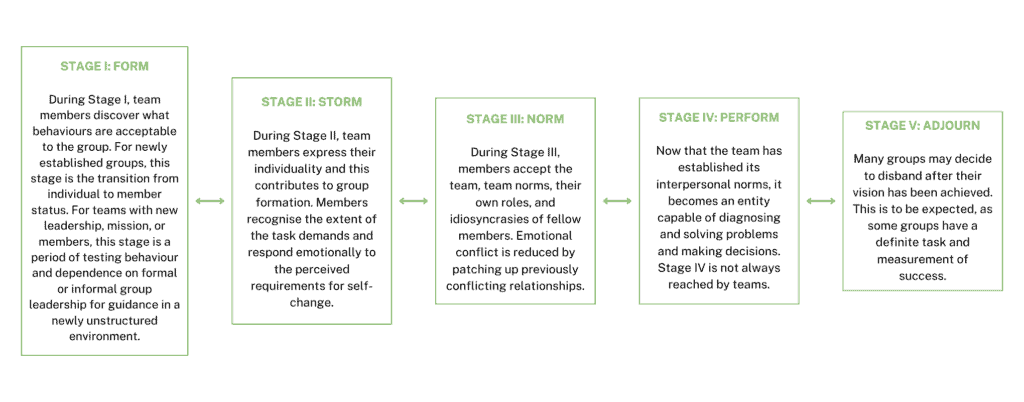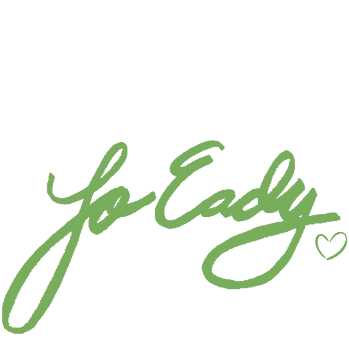I find any groups of people or teams fascinating to be a part of and or to watch as they make their way towards achieving visions and goals together that wouldn’t be possible on their own. I’ve been involved in many conversations with leaders as they talk about their teams. And I’m grateful that I know about Tuckman’s stages of group development. I’m surprised I can’t remember where I was when I first learnt about these stages as they have had a profound impact on me and the teams I’ve led. I’ve also used Tuckman’s model of group development as part of my leadership and consulting activities and group trainings and each time people sigh and say Ohhh I get it and can pinpoint exactly what stage their team is operating at right now and where they would like to be. And this then leads on to a session about how to support the team to get there. So today, I want to share these stages with you.
1. What is Tuckman’s Model of Group Stages?
Each great sport’s team needs a coach. This is someone who is able to support the players as individuals and then support them to work well as a team. This can, but usually doesn’t, happen all on its own. The coach’s role is important and is integral to the steady and sustained development of what a team achieves. And the best coaches or team leaders know that groups and teams go through predictable stages of development. I think it’s really useful for everyone in the team to understand these stages, and especially so if you lead a team . So, let’s look at the key stages now.

2. How to use Tuckman’s Stages of Group Development as a Tool
It’s great to know the predictable stages of a group’s development. And what’s even more important is how to use these stages to advantage. Here’s a suggested way to do just that.
- Identify the stage that your team is at from the descriptions above.
- Consider what you need to do to support individuals and your team to move on to the next stage.
- Facilitate regular reviews of where your team is at, and then adjust your leadership behaviour and your leadership approach to support individuals and the team as whole to move through the predictable stages.
Always remember too that the stages aren’t a one way street. The team is likely to go back and forth between the states depending on things like when a person leaves or joins the team or when the team is faced with a major change. I have seen time and time again how team leaders effortlessly support their team once they know the predictable behaviours and stages a team will go through.
3. How do I lead a team through the development stages?
Let’s look at the team stage transitions one at a time.
Forming to Storming
The key function at Forming stage is to set clear objectives for the team members and for the team. This might include a vision for the team that everyone buys into or group charter. It’s something the group members can refer to to ensure they understand how their personal goals fit with the bigger team picture. The Forming stage is all about people getting to know each other and building solid connections through interests and shared goals.
Storming to Norming
Many people share with me that they are worried by the Storming stage. I’m pretty sure this is because they associate Storming with conflict ad this isn’t the case. In saying that though, I do think Storming can make or break a team! This is the stage where people must feel safe to express themselves and their expertise in the group. It’s where systems and processes are important as regardless of the individuals personalities and relationships with each other, these systems and processes will ensure that everyone works to achieve the same outcome and will keep them focussed.
The team must feel safe in coming together and putting their ideas forward to their team leader and beyond. By doing this, they will feel valued and that their contribution counts. It’s important to keep an eye on tensions and conflict here and to support team members to “get on” by using the systems and processes in place. Be sure to take time to hear everyone’s view, especially those of the introverts or the quieter ones in the group.
Norming to Performing
Now you are here, it’s time to take your team even further. Bring them together, start doing more as a group than one on one with each individual team member. Support them to check in with the team’s vision and take a measure of how they are travelling towards this. I like using a simple self administered survey for this through Google docs or the like. I recommend doing this each 6 months or so. Keep it anonymous and I find team members are usually happy to share. There’s still plenty of room for one on one conversations with team members too here especially when roles and expectations of each role is different. The real key here is to ensure team members are taking responsibility for their actions.
Performing to Adjourning
Boost team engagement here and free up some time so that you can introduce something new to your team, now it’s working so well, or put your focus on to something else. This is also where you can identify some group development activities / training and or some personal development to support individuals. In fact, the best thing to do here is to ask the team what they need to assist them to move forward. Ensure they know what resources are available to them and if they think others are important to bring into the team.
Adjourning ( or Mourning)
Adjourning and then Mourning is when you know a group is going to change and not be the same again. Take time to identify and celebrate the teams achievements. I find thanking team members for their efforts isn’t enough, what works better is if they can truly acknowledge their positive contributions and achievements. This sets them up to work well again in the future if this eventuates and also ensures that the relationship you have with them will be secure if you enter into another team with them. I find some team members can feel really uncertain here and be worried about an uncertain future as they head off to work in another team or with another team leader. It’s important here to be truthful and to boost their confidence about how they can contribute positively to future teams.
Over to You
OK, take a deep breath. How is this all sitting? For now please remember Forming, Storming, Norming, Performing and Adjourning / Mourning. And then reread the sections about the transitions from one stage to the next. And then take time to reflect on your team contributions and achievements to date. After this, I encourage you to take one or two or maybe even three things from this article to help you work better in your team or to lead a team and put them in place today. Good luck. And please feel free to reach out to me here if you think I can help in any way.
Until next time!



